
Ziggurat of Ur
The Ziggurat of Ur, located near the modern city of Nasiriyah in southern Iraq, is a remarkable testament to the architectural and religious practices of ancient Mesopotamia. Built around 2100 BC during the Third Dynasty of Ur, this massive stepped pyramid served as a sacred center dedicated to the moon god Nanna.

Historical Significance
The Ziggurat of Ur played a central role in religious ceremonies, believed to bridge the gap between heaven and earth. It was part of the larger complex of the city of Ur, a prominent Sumerian city-state known for its advanced civilization and trade networks.
Architectural Features
Constructed from mudbrick and originally faced with kiln-fired bricks, the Ziggurat of Ur rose in three terraces to a height of about 64 feet (about 20 meters). Each terrace was dedicated to different aspects of religious rituals and ceremonies.
- Sacred Pathways: Zigzagging ramps led priests and worshippers to the top terrace, where rituals and offerings to the gods took place.
- Central Sanctuary: At the peak of the ziggurat, a temple housed a statue of the moon god Nanna, symbolizing divine presence and power.

Cultural Legacy
The Ziggurat of Ur symbolized the spiritual and cultural achievements of the Sumerian civilization. It also served as a focal point for community gatherings and religious festivals, showcasing the Sumerians’ architectural prowess and religious devotion.
Visitor Experience
Today, visitors to the Ziggurat of Ur can explore its reconstructed ruins and imagine the ancient rituals that once took place there. The site offers insights into the religious practices and architectural marvels of one of the earliest urban civilizations in human history.
Conservation Efforts
Efforts are ongoing to preserve and protect the Ziggurat of Ur from environmental factors and to ensure its continued accessibility for future generations. Conservation projects aim to maintain the integrity of the structure while promoting sustainable tourism practices.


Conclusion
The Ziggurat of Ur stands as a testament to the ingenuity and spiritual fervor of the ancient Sumerians. Its enduring presence on the Mesopotamian landscape invites modern visitors to contemplate the origins of urban civilization and the profound impact of religious beliefs on early societies. By exploring the ziggurat’s towering terraces and ancient sanctuaries, visitors embark on a journey through millennia of human history, discovering the timeless legacy of one of the world’s earliest architectural wonders.

